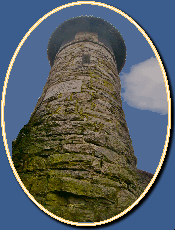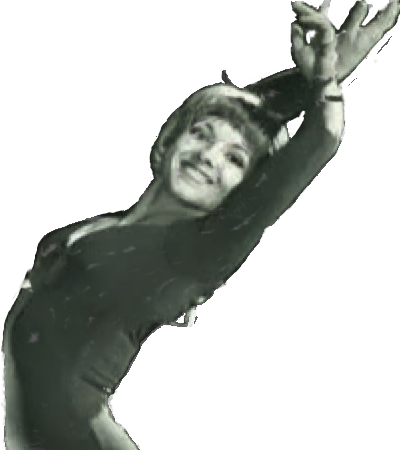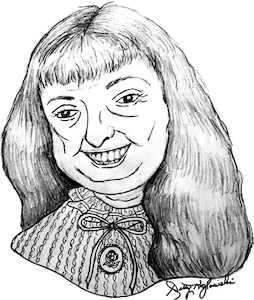Muriel Davis Grossfeld, daughter of Harry and Evelyn Davis, hailed from the Town of Speedway, Indiana, yes the home of the Indianapolis 500 racetrack. According to her brother, Bruce Davis, his sister was a voracious reader, straight-A student who took art, dance, ballet, acrobatic and diving lessons. Her father built a small dance school in their home’s basement so she could teach dance lessons when she was as young as age 11. Her brother stated in an interview that she disappointed her mother by choosing gymnastics over ballet.
Muriel (October 7, 1940 – January 17, 2021) attended St. Mary’s Academy. Across the street in downtown Indianapolis was Athenaeum Turners, a German social club. They had a gymnasium where the young acrobat was coached by Walt Lienert, a Navy veteran of World War II. “I went to classes every day. I did a lot of my own choreography,” Grossfeld told IndyStar in a 1996 interview. “I was very good at looking and learning. It made me see someone and do the same thing.”
By age 15 she was already good enough to attend the 1956 Olympic Trials at Penn State. At the trials, Grossfeld was eighth heading into the final event, balance beam. Only six would qualify for Melbourne. Another gymnast fell, and, by one-tenth of a point, she was on her way to Australia. “It sort of changed her life,” Lienert told IndyStar in 1996. At the 1956 Melbourne Olympics a collision involving a delivery truck left the gymnast with minor injuries. She competed despite bumps and bruises.
She was arguably one of the most important persons in the development of Women’s gymnastics in America. When American gymnastics was mostly an afterthought on the international scene she won a team gold medal at the 1963 Pan American Games. She competed in all artistic gymnastics events at the 1956, 1960 and 1964 Olympics and finished ninth with the American team four times taking all-around in all three games and in the team portable apparatus in 1956. Her best individual result was 19th place in the floor exercise in 1960. She earned a “10” at the 1964 Olympic Trials in floor exercise at Kings Point, N.Y. She went on to win 18 various national championships. She coached the U.S. women’s gymnastic teams at the 1968 and 1972 Olympic Games and at the World Championships in 1966, 1970 and 1974. She resolved to make the United States an international power in gymnastics. Grossfeld organized the first U.S. team training camp ahead of the 1966 World Championship.
Muriel and her husband Olympic gymnast Abie Grossfeld remained close after a divorce in 1966. They came to Connecticut and were instrumental in the growing Gymnastic program at Southern Connecticut State College in New Haven.
She started a private gymnastics school in Milford, Connecticut, first at the old A&P grocery store on River Street, then at the Masonic Temple on the Green and finally to a cinder block gym on Orange Avenue in the shadow of the Connecticut Turnpike.
As a USAG and USOC sanctioned facility, Grossfeld’s American Gold Gym (GAG) turned out tough gymnastic stars. According to People Magazine in 1978, she told one gymnast: “Don’t be a lady on that beam. Be an animal, Whatever you do, don’t fall off. Grab it with your teeth if you have to!”
At the time there were only three such special gymnastics-training centers in the country, the other two being
in Oregon and Louisiana. Dedicated prospects came from all over the country for years of incredibly hard work with only the hope of contesting the Soviet Bloc stars. In 1979 the New York Times reported on Grossfeld’s million dollar plans to expand the buildings and equipment on Orange Avenue. It was not to be. Constantly underfunded and neglected as a sport, Muriel spent most all of her income and fundraising on just keeping the doors open.
Grossfeld’s greatest coaching success was Marcia Frederick who began working out at the GAG at age 13. Frederick was a 15-year-old in 1978 when she became the first American to win a world title in women’s gymnastics (uneven bars). It was a great success for Grossfeld but marred by later claims that one of the eight GAG coaches, Richard Carlson, made sexual advances against her from age 16. She did not prevail in a subsequent lawsuit as claims against Grossfeld and her Gym were dismissed. Even so, it was part of a controversy that damaged both Muriel and the gymnastic sports training reputation nationally.
After the closing of the GAG Marcia did participate in the $425 Million settlement against Drs. Tyndall and Nasser and the USA Gymnastics (USAG) and US Olympic Committee (USOC) over sexual abuse of minor athletes led by Olympic star Aly Raisman decades later. In February 2018, the Safe Sport Act made it a federal crime not to report sexual assault or abuse claims to law enforcement.
After closing the GAG, Muriel continued to coach individual “elites” in the sport. Her longtime goal was finally achieved when the U.S. women won the team gold medal at the 1996 Atlanta. Olympics. Vivacious and beautiful, the 5’ 4” Grossfeld had a stint in Hollywood, staring in a TV Western pilot that did not get picked up. She also was a regular on ABC’s wide World of Sports for gymnastic color commentary and other coverage and a renowned spokeswoman for the sport.
The GAG training building is gone but the Platt house, a SRO dorm and living facilities, was moved to the adjacent Calvary Alliance Church, where it still stands, when the property was sold to build a convalescent hospital in the early 1980s.
In 1981 Muriel Grossfeld was inducted into the U.S. Gymnastics Hall of Fame. Memorializing Muriel Li Li Leung, CEO of USA Gymnastics said “Her passion for our sport was undeniable, and her efforts were instrumental to the growth of women’s gymnastics in the United States.”
The Muriel Grossfeld Scholarship Fund at Southern Connecticut University, and Muriel Grossfeld Invitational Gymnastics meet, also at Southern, live on after her passing. Grossfeld belongs to both USA Gymnastics and Women’s Sports Foundation halls of fame



